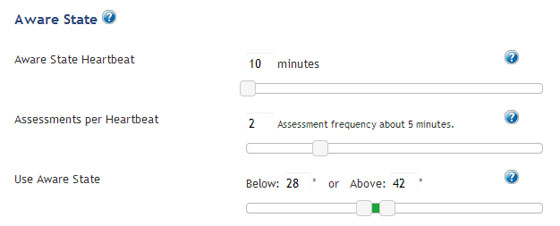
Understanding Sensor Settings and Operation
This tech-tip is meant to give an understanding of how Monnit wireless sensors function and how different settings affect sensor operation. For product documentation and additional help visit www.monnit.com/support.
To start, there are two types of sensor radio behaviors associated with Monnit wireless sensors. First there are "Event" type sensors that respond immediately to an event as it occurs (think of event type sensors as yes/no data). Second there are "Reading" type sensors that work on a timed basis to wake up at set intervals, gather data, transmit the data, then go back to sleep until the next interval.
Examples of event type sensors;
- water detection
- door/window
- motion
- dry contact, etc.
|
Examples of reading type sensors;
- temperature
- humidity
- voltage
- pressure, etc.
|
Every sensor has a heartbeat regardless of the type of radio behavior. Event type sensors use the heartbeat function to tell the system that they are still active (and will report the current sensor state as well as signal strength and battery status). Reading type sensors use the heartbeat as their set interval for gathering and sending information.

Reading type sensors also support "Assessments per Heartbeat", where the sensor will wake up, gather data and compare it against conditions set for the Aware State (see below), and if conditions are met, send that information to the software immediately (otherwise the sensor goes back to sleep). If using iMonnit Basic (Free) the assessments per heartbeat is automatically set to check six times per heartbeat (ex. every 20 minutes with a 2 hour heartbeat). If using iMonnit Premiere, you have control over how many assessments you want your sensors to take in between heartbeats.

Every sensor has an aware state function. The aware state allows the sensor to function at a higher level when certain conditions are met. For event type sensors, the detection of an event automatically triggers the aware state. For reading type sensors, the user sets the conditions that must be met for a sensor to enter it's aware state (also used for "Assessments per Heartbeat" above). Once in the aware state, the sensor will operate based on the "aware state" settings.
Setting the aware state heartbeat to a quicker interval allows the user to receive more frequent sensor information and/or notifications until the sensor reports a condition that is back in the normal operation range again.

Time to Re-Arm allows the user to define how long an event type sensor should take before it is allowed to detect another event. Example; if a motion sensor detects movement, setting a re-arm time of 1 second allows the sensor to detect movement again in just 1 second. This can allow the user to capture more frequent information if desired, but also uses more battery. Setting a re-arm time of 10 minutes preserves battery life but will not capture information again until the sensor is re-armed.

For more information on using Monnit wireless sensors, visit the support section of our website.
back to top
|



